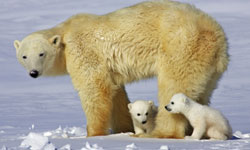The Arctic Ocean could soon be ice-free for a few days each summer, according to two national scientific agencies.
The ice cover is already the fourth-smallest on record at just 1.9 million square miles — and there are five weeks still left in the annual summer melting season, reports Bloomberg.
The data from the US National Snow and Ice Data Center (NSIDC) corroborates measurements released last week by the European Space Agency showing the ice is melting about 50% faster than scenarios envisioned by polar scientists.
"Unless the melting really, really slows down, there’s a very real chance of a record," Walt Meier, a research scientist at the NSIDC, told Bloomberg. "In the last week or so it’s dropped precipitously. There’s definitely a chance it’ll dip below 4 million square kilometers (1.5 million square miles)."

The ice is also becoming thinner. In regions north of Canada and Greenland, where ice thickness used to be 15-19 feet just 10 years ago, levels are now 3-9 feet thick, reports the Guardian.
At this rate, the Arctic Ocean could become ice free for a few days each summer within a few years, much quicker than anticipated, making it more vulnerable to oil and gas exploration interests, and new shipping routes.
"There’s a whole new frontline from a strategic standpoint," Cleo Paskal of policy advisor Chatham House told Bloomberg. "Countries that have been kept apart by a wall of ice are now facing each other for the first time and countries like China are slipping up through the middle."
"Preliminary analysis of our data indicates that the rate of loss of sea ice volume in summer in the Arctic may be far larger than we had previously suspected," Dr. Seymour Laxon, of the Centre for Polar Observation and Modelling at University College London (UCL), told the Guardian. "Very soon we may experience the iconic moment when, one day in the summer, we look at satellite images and see no sea ice coverage in the Arctic, just open water."
When more of the ocean is exposed, it absorbs rather than reflects the sun’s heat, which increases the warming effect. The melt could also release methane from previously frozen soil, further exacerbating the global warming effect.
"Our greatest concern is that loss of Arctic sea ice creates a grave threat of passing two other tipping points — the potential instability of the Greenland ice sheet and methane hydrates,” NASA’s top climate scientist, James Hansen, told Bloomberg. "These latter two tipping points would have consequences that are practically irreversible on time scales of relevance to humanity."
Siberian Arctic Collapse
More trouble lurks in one of the world’s least accessible regons, the Siberian Arctic.
A Stockholm University research team made the shocking discovery that an area four times the size of the United Kingdom is melting and eroding, rapidly converting to carbon and methane.
"Although this is a very remote region thousands of miles from the UK, considering the amount of carbon locked in this permafrost is twice the amount present in the atmosphere as CO2, the scale of the release of both CO2 and methane into the atmosphere will have a huge effect. "This will have consequences for the temperatures all over the world."
Read more:
